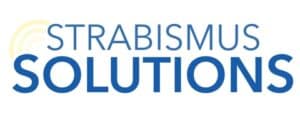I was nervous for my initial consultation and also very skeptical since I hadn’t done research, read about how I found vision therapy here. Would there actually be a difference between this optometrist and other eye doctors I’d been to previously? I definitely hoped so!
I walked into the office and it looked exactly the same as every other office. I sat down in the big chair and the optometrist had me read letters off a chart…20/20 in both eyes, the same result I always get, despite the fact that the images from one eye are blurry.
Then reading up close. Same old same old.
Then I looked through the big machine with all the lenses, a phoropter, nothing new.
Then he watched me follow a light while covering my eyes one at a time. I wasn’t impressed, everything seemed the same as every other eye appointment I’d ever been to.
Then he broke out something called the Worth Four Dot Test that I had never seen before. It kind of looks like a flashlight with four dots on the front, 2 green, 1 red, and 1 white. I put on a pair of glasses that had a red lens on one side and a green lens on the other side.

Then he had me look at the light (worth four dot tool) and tell him what I saw. I was amazed. I didn’t see four dots. I could feel my eyes switching from the left to the right and the lights were changing from 2 red dots to 3 green dots. This meant that I had alternating suppression.
At that point, he had my attention. He then went on to explain why I still couldn’t see well, even though I had 20/20 vision. He also explained that he could help me overcome the vision struggles I was having. He asked me what goals I had for my vision, I didn’t even know what I wanted, I just wanted it to be better. With that, he asked me to schedule another appointment for more in-depth testing.
The Testing
This in-depth testing or “Functional Vision Testing” involved so so many different vision tests that I could never name or recall. I will just mention a few things that I found particularly interesting.

First was the visagraph test. I put on special goggles and read a few passages and answered questions about what I had read. The visagraph glasses (I think I’m saying that right) track each eyes movement as you read and show it on a computer screen. There is a dot for each eye that follows the text and basically shows where your eyes jump or went back to read a section a second time. I find this test super fascinating. My eyes jumped all over the place and my comprehension wasn’t great. It’s always good to see that there is room for improvement.
He had me tracking a pencil from side to side and I thought I was doing great, but I soon realized that I was not tracking smoothly, my eyes jumped.
The testing almost seemed over the top. He literally tested everything there is possible to check with my vision in more than one way. I loved that he was being so thorough.
He also tested my primitive reflexes to see if there were any that I was retaining. This looked like me pointing my toes in and trying to walk down a line (pigeon) and then pointing them out and trying to walk (duck). He watched the rest of my body to see if some of those primitive reflexes were coming into play. I didn’t have a huge problem in this area though.
The Consultation
As I went in for the first few appointments I started researching more and more about vision therapy and I started finding that it is a huge time commitment and very expensive.
My husband came with me to the consult and Dr. Nielson helped him understand what I was going through, trying to convince him that vision therapy was worth the cost. The different tests did help him understand the way I “see” the world better.
Here are the testing results that I got:
| Distance | Near | ||
| Visual Acuity | Right Eye | 20 | 25- |
| Left Eye | 20 | 20 |
| Raw Score | Ability | |
| Pursuit Eye Movements | 1+ | Significantly below Expected |
| Test | Finding | Expected | Ability |
| Accommodative Amplitudes | Right: 4 | Right: 7 | Significantly Below Expected |
| Left: 4 | Right: 7 | Significantly Below Expected |
For the
My stereo acuity was 0 seconds of arc, it can go as high as 40!
My doctor explained that because of my constant exotropia, which was measured at 30 diopters at distance and near, my brain was suppressing the image from one eye causing stereo blindness.
He suggested 32-40 weekly visits to improve accommodation and saccadic skill, eliminate my eye turn, and help me learn to fuse images. The total cost ended up being $4320, which isn’t terrible in the vision therapy world. But in my world, that’s

After a lively discussion about other options, we settled on an alternative plan. I would spend a few months working on some foundational skills and come in every 4-6 weeks for progress checks. Once the foundation was a little stronger, I would start officially. Check out this post to see what my initial treatment plan looked like.
